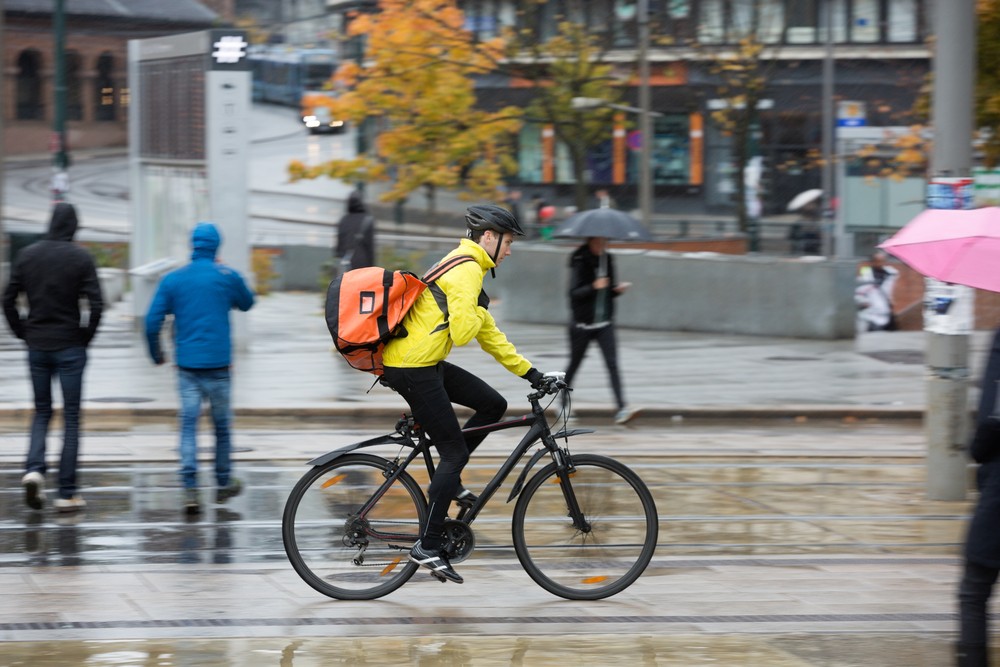
мөңнҳ„мӣ… кё°мһҗ = лҸ„мӢңмқҳ кұ°лҰ¬лҘј лҲ„비лҠ” н”ҪмӢң мһҗм „кұ°к°Җ н•ҳлӮҳмқҳ л¬ёнҷ” нҳ„мғҒмңјлЎң мһҗлҰ¬ мһЎкі мһҲлӢӨ. 'н”ҪмҠӨл“ң кё°м–ҙ л°”мқҙнҒ¬(Fixed Gear Bike)'мқҳ м• м№ӯмқё н”ҪмӢң мһҗм „кұ°лҠ” ліҖмҶҚкё°мҷҖ н”„лҰ¬нң мқҙ м—Ҷм–ҙ нҺҳлӢ¬мқ„ л°ҹлҠ” лҢҖлЎң л°”нҖҙк°Җ лҸҢм•„к°ҖлҠ” лӢЁмҲңн•ң кө¬мЎ°к°Җ нҠ№м§•мқҙлӢӨ. мқҙ к°„кІ°н•Ёмқҙ мҳӨнһҲл Ө м ҠмқҖ м„ёлҢҖм—җкІҢ л§Өл ҘмңјлЎң мһ‘мҡ©н•ҳл©°, м „ м„ёкі„ лҸ„мӢңмқҳ мЈјмҡ” көҗнҶөмҲҳлӢЁмқҙмһҗ мһҗкё°н‘ңнҳ„мқҳ мҲҳлӢЁмңјлЎң л– мҳӨлҘҙкі мһҲлӢӨ.
н•ҙмҷё л§ӨмІҙл“ӨмқҖ мқҙлҹ¬н•ң н”ҪмӢң мһҗм „кұ°мқҳ мқёкё° мғҒмҠ№м„ёлҘј мЈјлӘ©н•ҳкі мһҲлӢӨ. 2025л…„ мӢңмһҘ ліҙкі м„ңм—җ л”°лҘҙл©ҙ, м „ м„ёкі„ н”ҪмӢң мһҗм „кұ° мӢңмһҘ к·ңлӘЁлҠ” 2025л…„ 24м–ө 5мІңл§Ң лӢ¬лҹ¬(н•ңнҷ” м•Ҫ 3мЎ° 3мІңм–ө мӣҗ)м—җ лӢ¬н• кІғмңјлЎң м¶”м •лҗҳл©°, 2032л…„к№Ңм§Җ м—°нҸүк· 6.4%мқҳ м„ұмһҘмқҙ мҳҲмғҒлҗңлӢӨ. нҠ№нһҲ, м•„мӢңм•„ нғңнҸүм–‘ м§Җм—ӯмқҙ 35.8%мқҳ мӢңмһҘ м җмң мңЁлЎң м„ л‘җлҘј лӢ¬лҰ¬кі мһҲмңјл©°, л¶ҒлҜё м§Җм—ӯмқҖ 29.7%мқҳ м җмң мңЁлЎң к°ҖмһҘ л№ лҘё м„ұмһҘм„ёлҘј ліҙмқҙкі мһҲлӢӨ. мқҙлҠ” л°Җл ҲлӢҲм–ј м„ёлҢҖмҷҖ Zм„ёлҢҖк°Җ мЈјлҸ„н•ҳлҠ” мғҲлЎңмҡҙ лҸ„мӢң мһҗм „кұ° л¬ёнҷ”мҷҖ н•Ёк»ҳ, лүҙмҡ•, мғҢн”„лһҖмӢңмҠӨмҪ”мҷҖ к°ҷмқҖ лҢҖлҸ„мӢңмқҳ мһҗм „кұ° мқён”„лқј нҷ•м¶©мқҙ мҳҒн–Ҙмқ„ лҜём№ң кІғмңјлЎң 분м„қлҗңлӢӨ.
н”ҪмӢң мһҗм „кұ°к°Җ мқёкё°лҘј м–»лҠ” мқҙмң лҠ” к·ё лҸ…нҠ№н•ң нҠ№м„ұ л•Ңл¬ёмқҙлӢӨ. <нҠёл ҲмҠӨлӮҳ(Tresna)>мҷҖ к°ҷмқҖ н•ҙмҷё мһҗм „кұ° м „л¬ё л§ӨмІҙл“ӨмқҖ н”ҪмӢңмқҳ мһҘм җмңјлЎң кІҪлҹүм„ұ, лӮ®мқҖ мң м§ҖліҙмҲҳ 비мҡ©, к·ёлҰ¬кі к°ңм„ұмқ„ мӨ‘мӢңн•ҳлҠ” л””мһҗмқёмқ„ кјҪлҠ”лӢӨ. ліҖмҶҚкё°мҷҖ лёҢл ҲмқҙнҒ¬ л“ұмқҳ л¶Җн’Ҳмқҙ м—Ҷм–ҙ л¬ҙкІҢк°Җ к°ҖліҚкі , кі мһҘ лӮ л¶Җ분мқҙ м Ғм–ҙ кҙҖлҰ¬к°Җ мҡ©мқҙн•ҳлӢӨлҠ” кІғмқҙлӢӨ. лҳҗн•ң, н”„л Ҳмһ„, нң , н•ёл“Өл°” л“ұ лӢӨм–‘н•ң л¶Җн’Ҳмқ„ м»ӨмҠӨн„°л§Ҳмқҙ징н•ҳм—¬ мһҗмӢ л§Ңмқҳ лҸ…нҠ№н•ң мһҗм „кұ°лҘј л§Ңл“Ө мҲҳ мһҲлӢӨлҠ” м җмқҙ 'нһҷмҠӨн„°' л¬ёнҷ”мҷҖ кІ°н•©н•ҳл©° нҒ° л§Өл ҘмңјлЎң мһ‘мҡ©н•ҳкі мһҲлӢӨ.
н•ҳм§Җл§Ң н”ҪмӢң мһҗм „кұ°мқҳ мқёкё°мҷҖ н•Ёк»ҳ м•Ҳм „ л¬ём ңм—җ лҢҖн•ң мҡ°л ӨлҸ„ м»Өм§Җкі мһҲлӢӨ. нҠ№нһҲ, мқјл¶Җ мқҙмҡ©мһҗл“Өмқҙ лёҢл ҲмқҙнҒ¬лҘј м ңкұ°н•ҳкі мЈјн–үн•ҳлҠ” кІҪмҡ°к°Җ л§Һм•„ мӮ¬нҡҢм Ғмқё л…јлһҖмқҙ лҗҳкі мһҲлӢӨ. нҺҳлӢ¬мқ„ л©Ҳ추кұ°лӮҳ л’ӨлЎң лҸҢл Ө л’·л°”нҖҙлҘј лҜёлҒ„лҹ¬лңЁлҰ¬лҠ” 'мҠӨнӮӨл”©(skidding)' кё°мҲ лЎң м ңлҸҷн•ҳм§Җл§Ң, мқҙлҠ” мқјл°ҳ мһҗм „кұ°ліҙлӢӨ м ңлҸҷ кұ°лҰ¬к°Җ нӣЁм”¬ кёёкі лҸҢл°ң мғҒнҷ©м—җ лҢҖмІҳн•ҳкё° м–ҙл өлӢӨлҠ” лӢЁм җмқ„ к°Җм§Җкі мһҲлӢӨ.
мӢӨм ңлЎң мқјліёмқҳ н•ң м–ёлЎ ліҙлҸ„м—җ л”°лҘҙл©ҙ, 2011л…„ лӢ№мӢң лёҢл ҲмқҙнҒ¬ м—ҶлҠ” н”ҪмӢң мһҗм „кұ° лӢЁмҶҚ кұҙмҲҳк°Җ 2009л…„ 2кұҙм—җм„ң 2010л…„ 661кұҙмңјлЎң кёүмҰқн•ң мӮ¬лЎҖк°Җ мһҲлӢӨ. мқҙлҠ” н”ҪмӢң мқҙмҡ©мһҗ мҰқк°ҖмҷҖ н•Ёк»ҳ м•Ҳм „ л¬ём ңк°Җ мӢ¬к°Ғн•ҳкІҢ л¶ҖмғҒн–ҲмқҢмқ„ ліҙм—¬мЈјлҠ” нҶөкі„лӢӨ. 2025л…„ 8мӣ” 16мқјмһҗ м—°н•©лүҙмҠӨ ліҙлҸ„м—җм„ңлҸ„ лёҢл ҲмқҙнҒ¬ м—ҶлҠ” н”ҪмӢң мһҗм „кұ°лҘј нғҖлҚҳ мӨ‘н•ҷмғқмқҙ мӮ¬л§қн•ҳлҠ” мӮ¬кі к°Җ л°ңмғқн•ҙ кІҪм°°мқҙ лӢЁмҶҚмқ„ к°•нҷ”н•ҳкі мһҲлӢӨлҠ” мҶҢмӢқмқҙ м „н•ҙмЎҢлӢӨ.
м „л¬ёк°Җл“ӨмқҖ н”ҪмӢң мһҗм „кұ°мқҳ м•Ҳм „н•ң мқҙмҡ©мқ„ мң„н•ҙм„ңлҠ” л°ҳл“ңмӢң лёҢл ҲмқҙнҒ¬лҘј мһҘм°©н•ҙм•ј н•ңлӢӨкі к°•мЎ°н•ңлӢӨ. лҜёкөӯ мәҳлҰ¬нҸ¬лӢҲм•„мЈјмқҳ н•ң ліҖнҳёмӮ¬лҠ” "лҢҖл¶Җ분мқҳ мЈјм—җм„ң н”ҪмӢң мһҗм „кұ°лҠ” мөңмҶҢн•ң м•һ лёҢл ҲмқҙнҒ¬лҘј мһҘм°©н•ҙм•ј н•©лІ•м ҒмңјлЎң лҸ„лЎңм—җм„ң мҡҙн–үн• мҲҳ мһҲлӢӨ"л©° "мІҙмқёмқҙ лҒҠм–ҙм§Ҳ кІҪмҡ° м ңлҸҷмқҙ л¶Ҳк°ҖлҠҘн•ҙм§ҖлҠ” м№ҳлӘ…м Ғмқё мң„н—ҳмқҙ мһҲлӢӨ"кі кІҪкі н–ҲлӢӨ. н”ҪмӢң мһҗм „кұ°мқҳ м•Ҳм „н•ң мЈјн–үмқ„ мң„н•ҙм„ңлҠ” 헬멧과 к°ҷмқҖ ліҙнҳё мһҘкө¬лҘј м°©мҡ©н•ҳкі , кі лӮңлҸ„мқҳ мЈјн–ү кё°мҲ ліҙлӢӨлҠ” м•Ҳм „н•ң лқјмқҙл”©м—җ мҙҲм җмқ„ л§һм¶°м•ј н•ңлӢӨлҠ” кІғмқҙ м „л¬ёк°Җл“Өмқҳ кіөнҶөлҗң мқҳкІ¬мқҙлӢӨ.
н”ҪмӢң мһҗм „кұ°лҠ” лӢЁмҲңн•ң мқҙлҸҷ мҲҳлӢЁмқ„ л„ҳм–ҙ, 'мһҗмң 'мҷҖ 'к°ңм„ұ'мқ„ н‘ңнҳ„н•ҳлҠ” м ҠмқҖ м„ёлҢҖмқҳ м•„мқҙмҪҳмқҙ лҗҳм—ҲлӢӨ. н•ҳм§Җл§Ң мқҙлҹ¬н•ң л¬ёнҷ”к°Җ м§ҖмҶҚм ҒмңјлЎң м„ұмһҘн•ҳкё° мң„н•ҙм„ңлҠ” м•Ҳм „м—җ лҢҖн•ң мқёмӢқмқ„ н•Ёк»ҳ лҶ’м—¬м•ј н•ңлӢӨлҠ” кіјм ңлҘј м•Ҳкі мһҲлӢӨ.
[м№јлҹјм ңкіө]
м•„мқҙнӢ°мқёмӮ¬мқҙнҠё мөңнҳ„мӣ… кё°мһҗ
sihun69@gmail.com
https://blog.naver.com/sihun69
Reporter Choi Hyun-woong = The fixed-gear bicycle, or "fixie," is establishing itself as a cultural phenomenon on city streets. The fixie, an affectionate nickname for a 'Fixed Gear Bike,' is characterized by its simple structure without a freewheel or gears, meaning the wheels turn directly with the pedals. This simplicity has become attractive to the younger generation, making it a prominent mode of urban transport and a means of self-expression worldwide.
International media outlets are noting the rising popularity of fixed-gear bikes. According to a 2025 market report, the global fixed-gear bike market is estimated to reach $2.45 billion in 2025 and is expected to grow at an annual average rate of 6.4% until 2032. The Asia-Pacific region is leading the market with a 35.8% share, while North America is showing the fastest growth at 29.7% of the market. This is analyzed as a result of the new urban cycling culture led by the Millennial and Gen Z generations, as well as the expansion of bicycle infrastructure in major cities like New York and San Francisco.
The popularity of fixed-gear bikes is due to their unique characteristics. International cycling media outlets such as <Tresna> cite their advantages as lightweight design, low maintenance requirements, and a customizable aesthetic. The absence of parts like derailleurs and brakes makes the bikes lighter and easier to maintain. Additionally, the ability to customize various components like the frame, wheels, and handlebars to create a unique bike has combined with 'hipster' culture to become a major attraction.
However, along with the bikes' popularity, concerns about safety issues are also growing. In particular, the practice of some riders removing their brakes has become a social controversy. While they can brake using a 'skidding' technique by stopping or reversing the pedals to make the rear wheel slide, this method has a much longer braking distance than a regular bicycle and makes it difficult to react to sudden situations.
In fact, according to a Japanese news report, the number of incidents involving brakeless fixed-gear bikes surged from just 2 in 2009 to 661 in 2010. This statistic shows that as fixie usage increased, safety issues became a serious concern. A report from Yonhap News Agency on August 16, 2025, also reported that a middle school student died while riding a brakeless fixed-gear bike, leading the police to intensify enforcement.
Experts emphasize that for safe use, fixed-gear bikes must be equipped with brakes. A lawyer in California warned that "in most states, fixed-gear bikes are required to have at least a front brake to be legally ridden on the road," and that "there is a fatal risk of being unable to stop if the chain breaks." The common opinion among experts is that for safe riding, users should wear protective gear like helmets and focus on safe riding practices rather than on high-level riding techniques.
The fixed-gear bike has evolved from a simple mode of transport to an icon for the younger generation, expressing 'freedom' and 'individuality.' However, for this culture to continue to grow, it faces the challenge of also raising awareness about safety.
[Column Provided by] Choi Hyun-woong, Reporter at IT Insight sihun69@gmail.com https://blog.naver.com/sihun69









